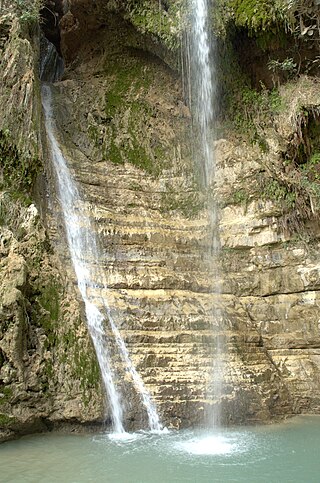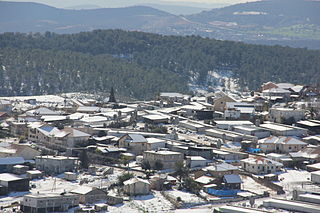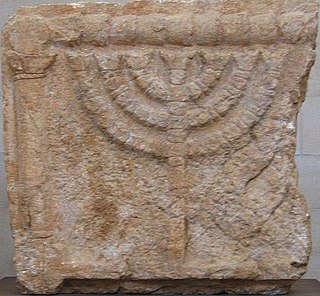
Tel Rehov or Tell es-Sarem, is an archaeological site in the Bet She'an Valley, a segment of the Jordan Valley, Israel, approximately 5 kilometres (3 mi) south of Beit She'an and 3 kilometres (2 mi) west of the Jordan River. It was occupied in the Bronze Age and Iron Age.

Ein Gedi, also spelled En Gedi, meaning "spring of the kid", is an oasis, an archeological site and a nature reserve in Israel, located west of the Dead Sea, near Masada and the Qumran Caves. Ein Gedi, a kibbutz, was established nearby in 1954.

The Jericho synagogue dates to the late 6th or early 7th century CE and was discovered in Jericho in 1936. All that remains from the ancient prayer house is its mosaic floor, which contains an Aramaic inscription presenting thanks to the synagogue donors, and a well-preserved central medallion with the inscription "Shalom al Israel", meaning "Peace [up]on Israel". This led to the site also being known as Shalom Al Israel Synagogue.

Mampsis or Memphis, today Mamshit, Kurnub, is a former Nabataean caravan stop and Byzantine city. In the Nabataean period, Mampsis was an important station on the Incense Road, connecting Southern Arabia through Edom, the Arabah and Ma'ale Akrabim, to the Mediterranean ports, as well as to Jerusalem via Beersheba and Hebron. The city covers 10 acres (40,000 m2) and is the smallest but best restored ancient city in the Negev Desert. The once-luxurious houses feature unusual architecture not found in any other Nabataean city.

Dalton is a moshav near Safed in northern Israel under the jurisdiction of Merom HaGalil Regional Council. It was founded by immigrants from Tripoli in Libya in 1950 under the leadership of Hapoel HaMizrachi.
Beth Alpha is a sixth-century CE synagogue located at the foot of the northern slopes of the Gilboa mountains near Beit She'an, Israel. It is now part of Bet Alfa Synagogue National Park and managed by the Israel Nature and Parks Authority.

Tzippori Synagogue is an ancient synagogue discovered in Sepphoris, a Roman-era Jewish city in the Galilee, now an archaeological site and a national park in Israel.

The Maon Synagogue is a 6th-century synagogue and archaeological site located in the Negev Desert near Kibbutz Nirim and Kibbutz Nir Oz. It is noted for its "magnificent" mosaic floor.

Ancient synagogues in Palestine refers to synagogues and their remains in the Land of Israel/Palestine region, built by the Jewish and Samaritan communities from the time of the Hasmonean dynasty during the Late Hellenistic period, to the Late Byzantine period.

The Jay and Jeanie Schottenstein National Campus for the Archaeology of Israel is the future building of the Israel Antiquities Authority. Construction began in 2012 in Jerusalem, the building will concentrate all centralized administrative offices into one structure. The campus is being built on 20,000 square meters located between the Israel Museum and the Bible Lands Museum. It was designed by Moshe Safdie.

The Archeological Survey of Israel aims to survey the entire area of the State of Israel documenting and mapping all its archaeological sites. Executing the survey was entrusted to the Israel Antiquities Authority (IAA), as they map, measure, photograph the sites while collecting important information about them.

Khirbet Kurkush is an archeological site in the West Bank. It lies between the Israeli settlements of Bruchin and Ariel and near the Palestinian town of Bruqin, in the Salfit Governorate of the State of Palestine.
The Synagogue-Church at Gerasa in northwestern Jordan was originally an ancient Byzantine era synagogue that was later converted to a church. It is located within the Decapolis city of Gerasa and is situated on high ground that overlooks the Temple of Artemis at Gerasa. The synagogue is evidence of Jewish settlement in the Transjordan through late antiquity.

The Bar Kokhba refuge caves are natural caves that were used for shelter by Jewish refugees during the later phases of the Bar Kokhba revolt. Most of the refuge caves were located in the Judaean Desert, nestled within steep cliffs far away from settlements, many overlooking the Dead Sea and the Jordan Valley. Some were also found in ravines flowing into the Dead Sea, while others were nestled within the Judaean Mountains. Unlike the other two hideout systems used by the rebels, the man-made rock-cut hiding complexes, and the hard-to-reach cliff shelters which often contain hewn installations, the refuge caves remained largely untouched by human intervention.

Ancient Jewish art, is art created by Jews in both the Land of Israel and in the Diaspora prior to the Middle Ages. It features symbolic or figurative motifs often influenced by biblical themes, religious symbols, and the dominant cultures of the time, including Egyptian, Hellenistic, and Roman art.

Humibaba was a female adult Arabian leopard who lived in the Nahal David area of the Ein Gedi Nature Reserve in the Judean Desert in Israel. She became known as the oldest leopard in the Judean Desert, and numerous articles in the Israeli media followed her story over the years. Among other things, a regular column about her and other leopards in the Judean Desert was published in the youth newspaper "Sal'it".

The Deir Aziz synagogue is an ancient synagogue dating from the Mishnaic and Talmudic periods, located at the archeological site of Deir Aziz, in the southern Golan Heights.

The man in the wall is a unique relief of a Roman soldier curved in an Hellenistic style into a cliff wall near the Temple cave above Nahal Kziv, by the settlement of Abirim.

Ein Gedi was an important Jewish settlement on the western shore of the Dead Sea in ancient times. The ruins, including the 6th century Ein Gedi synagogue, home to one of the most impressive mosaic floors in Israel, testify to a continuous Jewish settlement in the area for over 1,300 years, from the 7th century BCE to the 6th century CE.

The use of stone vessels made from soft limestone/chalkstone among Jews during the Second Temple period and beyond was widespread across Judea, Galilee and the Golan Heights. Initially appearing in the early 1st century BCE, these vessels continued to be utilized in each region for differing lengths of time.




















